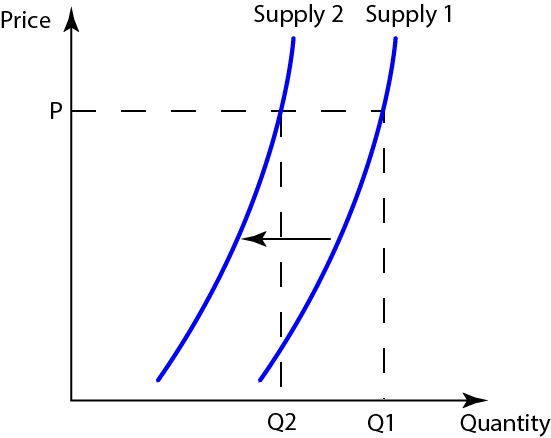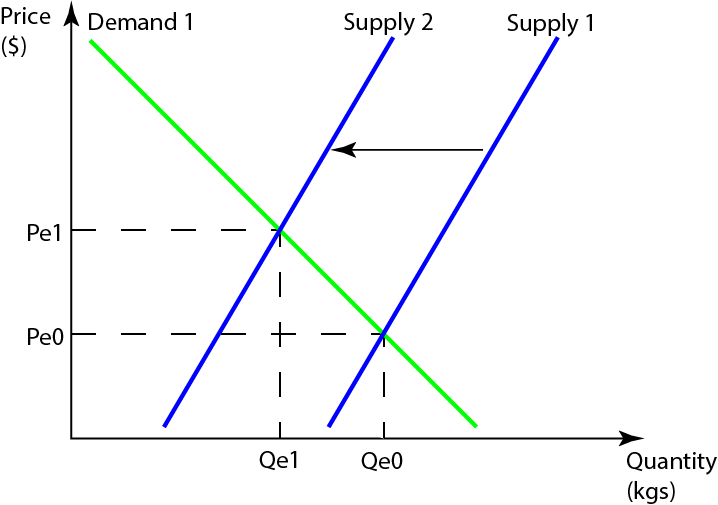The Determinants That Lead to the Price Changes in the Australian Vegetable Market
Increase in the Price of Inputs
Following challenges in the agricultural output of vegetables in Australia, the price of vegetables has gone up. In particular, several determinants of vegetable prices in Australia have been impacted to cause this rise. Firstly, the price of agricultural inputs has gone up, especially the price of fertilizers and fuel, due to the ongoing war in Ukraine (Breen & Locke, 2022). For this reason, Australian farmers found it difficult to till their lands as they would typically do in the seasons leading up to this consumption season. An increase in farm inputs might cause the supply curve to shift to the left, illustrating this:

Decrease in Farm Activity
Moreover, there were unprecedented La Nina rains that caused flooding in some of the most productive lands in Australia and, in turn, caused a decrease in farm activity. As a consequence, there has been a decrease in the supply of fresh vegetables in the market due to a decrease in productivity. Australia is noted as one of the global leaders in agriculture and is, therefore, largely self-reliant and food-secure (Candy et al., 2019). There are hardly any food imports, and a decline in food production is likely to occur right away in consumer markets. Thus, the La Nina rains cause a leftward shift in the supply curve of vegetables in the Australian market, as shown below:

Decrease in Productivity
Thirdly, a shortage of immigrant workers also affects supply. Boucher (2019) points out that temporary immigrant workers make up 11% of the Australian labor force. Thus, a decrease in immigrant workers can considerably hamper agricultural productivity. Similar to the other two factors, this is likely to cause a leftward shift in the supply curve, signifying a shrinkage in overall supply as shown below:

Following the leftward shift in the supply curve, it is important to analyze the demand side for vegetables as well. Assuming that the demand for vegetables has remained constant immediately, an increase in the equilibrium price would be observed due to the leftward shift in demand as shown in Figure 1, Figure 2, and Figure 3 above. The equilibrium price, or the price at which the demand curve and supply curve intersect, will shift upwards, primarily indicating an increase. Thus, Australian vegetable buyers will experience an increase in the price of vegetables due to the factors discussed, namely: The global increase in the price of fertilizers and fuel, La Nina rains, and fewer immigrant workers. The new equilibrium price is illustrated below:

Note: Equilibrium price increases from Peo to Pe1 following the leftward shift of the supply curve from Supply 1 to Supply 2.
The Elasticity of the Demand for Fresh Vegetables in Australia
Substitute Availability
The price elasticity of vegetables in Australia is a measure of how much the demand for fresh vegetables changes when the price changes. One of the factors that would determine and facilitate the assessment of the price elasticity of demand for fresh vegetables is the availability of close substitutes. Breen and Locke (2022) note that one of the substitutes for fresh vegetables is frozen vegetables. They note that frozen vegetables are experiencing higher demand and even shortages as the price of fresh vegetables skyrockets across retail and grocery outlets. This is evidence that with an increase in the price of fresh vegetables, more consumers are going for the alternative, thus effectively lowering the demand for fresh vegetables. From this, one can infer that the demand for fresh vegetables in Australia is price elastic.
Consumer Willingness to Buy
Another indicator that the demand for fresh vegetables is price elastic is the self-admission of several consumers. Breen and Locke (2022) document the attitudes of consumers to the price of vegetables and their willingness and ability to meet the prevailing market rates. For instance, one consumer admits that buying local fresh vegetables will only be feasible until a certain price limit is reached, beyond which they must consider alternatives. Another consumer reports that they would not buy lettuce at $12 (Breen & Locke, 2022). These two reports by consumers indicate that the demand for fresh vegetables is significantly affected by the price. Notably, there is less demand when the price increases, which describes the price elasticity of the demand curve.
The Impact of the Price Change on an Individual Farmer’s Revenue
Due to the price elasticity of demand, the farmer’s revenue will fluctuate accordingly. Notably, the farmer will rely on the movement along the demand curve to determine their revenue. In particular, the increase in the price of fresh vegetables will result in a new demand quantity. A demand schedule presents a tabulated format of the quantity that will be demanded at each progressive price point:

Total revenue can either increase or decrease with a change in price and quantity demanded. Total revenue is a product of the quantity demanded and the price in dollars at each point. Therefore, the revenue due to the farmer will fluctuate either upwards or downwards. Mankiw (2018) notes that the effect of price on total revenue is governed by the price elasticity of demand. In particular, the absolute value of price elasticity(eD) is calculated using real-life variables as follows:
eD = % change in quantity demanded / % change in price
From the above equation, if price elasticity(eD) is greater than one, the demand is price elastic. If it is equal to one, it is termed as unit price elastic. Lastly, if price elasticity(eD) is less than one, it is price inelastic. Mankiw (2018) expounds by adding that if demand is price elastic, the change in total revenue will mirror the change in quantity change. On the other hand, if demand is unit price elastic, total revenue will not change with a change in price or quantity demanded. Finally, if demand is price inelastic, the price change will be reflected in the change in total revenue.
References
Breen, F., & Locke, S. (2022). Can shoppers keep buying local in a season of product shortages and price hikes? ABC News. Web.
Boucher, A. (2019). Measuring migrant worker rights violations in practice: The example of temporary skilled visas in Australia. Journal of Industrial Relations, 61(2), 277–301. Web.
Candy, S., Turner, G., Larsen, K., Wingrove, K., Steenkamp, J., Friel, S., & Lawrence, M. (2019). Modelling the food availability and environmental impacts of a shift towards consumption of healthy dietary patterns in Australia. Sustainability, 11(24), 7124. Web.
Mankiw, N. G. (2018). Principles of economics (8th ed.). Cengage Learning.
